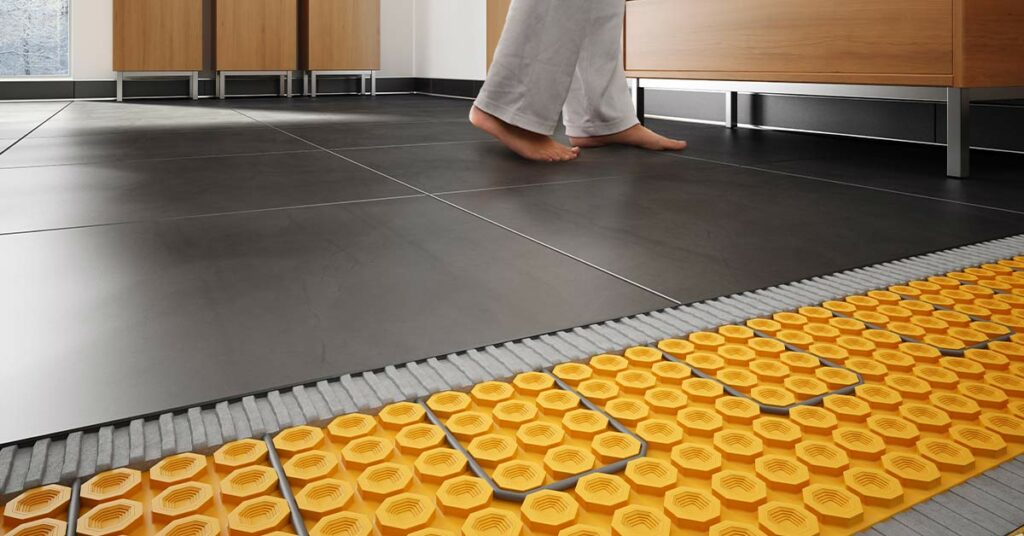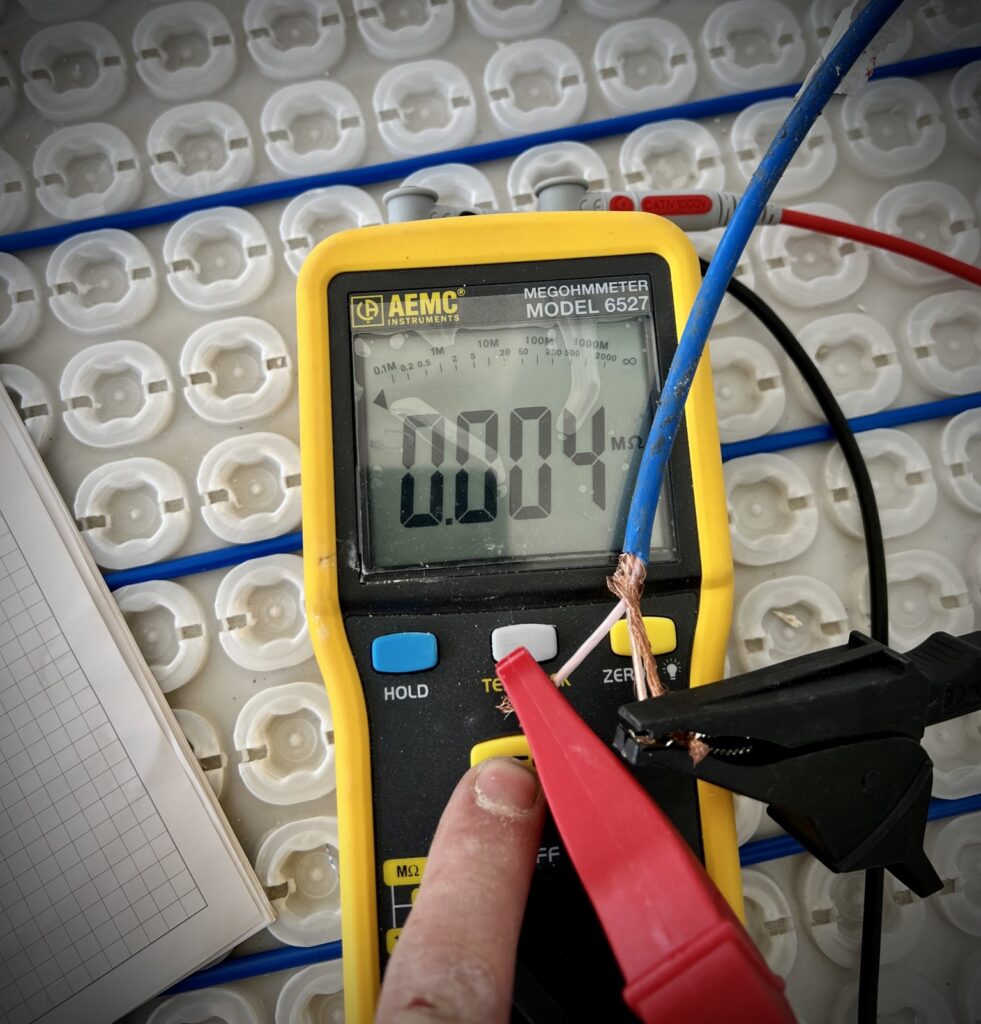
Experience the luxury of radiant heated tile floors.
Radiant heated tile floors have become increasingly popular in recent years. “Everyone who has a heated tile floor installation has absolutely raved about how much they love it,” says Adam Copher, owner of Copher Tile and Stone. To install heated floors, existing flooring must be removed. Are you replacing existing floors or installing new floors? Now is the perfect time to get heated flooring. Read this article to learn about the benefits of radiant heated tile flooring and get answers to common questions.
Heated Floors Have Come a Long Way
Traditionally, consumers have viewed heated floors as difficult to install and expensive. Hydronic underfloor heating (wet floor heating) adds a lot of height to floors. It requires regular professional maintenance. The system takes a long time to heat up. Older electric radiant heating systems have been problematic, too. Heating cables had to be embedded in thinset or cement. Then, everyone would have to wait around for the substrate to completely dry and cure before the flooring could be installed.
Advances in technology have simplified the installation processes for radiant heating under tile floors. The systems are now more economical than people realize, too. Here’s how it works. The installer attaches a layer of material (an uncoupling membrane) to the subfloor using a bonding material like thinset. The heating cables are installed in this membrane. Then, the installer can immediately begin setting tile.
Benefits Compared to Other Heating
Whether electric radiant heated tile flooring is a primary or a secondary heat source, it delivers numerous benefits, including:
Energy Savings. With an electric radiant heating system under your tile, heat is delivered from below. Unlike forced air systems, the heat spreads evenly throughout the living space. With HVAC systems, a significant portion of energy is lost in the ducts. Electric radiant heating systems do not have ducts. According to the U.S. Department of Energy, “It is more efficient than baseboard heating and usually more efficient than forced-air heating because it eliminates duct losses.” Learn how to calculate your current heating system energy costs here.
Comfort and convenience. Like sunshine warming your skin on a cool day, heated tile floors pamper your feet with luxurious comfort. Plus, when the system activates and deactivates, there is no noise. There are many optional features available with heated tile floors. Programmable thermostats. Customized zone heating. Quick warm up. Tracking and logging power consumption. Using wifi to control your heating system on web and mobile apps or Google Assistant, Alexa, Siri, and more.
Improved indoor air quality. Forced air heating systems circulate dust and allergens. For people with asthma and allergies, this can be a real problem. These systems also dry out the air in your home. According to the Mayo Clinic, the ideal humidity level in a home is 30-50%. When the humidity level is too low, you, your family, and guests may experience itchy, dry eyes and skin and irritated noses and throats. With an electric radiant heating underfloor system these problems can be avoided.
Safety. Forced air heating systems and space heaters require space to promote air flow and reduce the risk of a fire hazard. Trip and fall accidents are a concern when there are area rugs and throw rugs in walkways. Heating equipment cords can pose a trip and fall hazard, as well. An electric radiant heated tile flooring system frees you from all of these concerns.
Aesthetic benefits. Forced air heating systems take up space with ducts and unsightly wall vents. This can hamper your style when it comes to interior design. With heated tile floors, you are free to hang drapery, arrange furniture, and make other design decisions.
Increased home value. If your flooring needs replacement, consider heated flooring, which Zillow research found could add a 2.4% premium on your home sale price.
Answers to Common Questions
Here are some common questions about radiant heated tile flooring. Feel free to give us a call if you have a specific question not mentioned here.
Will adding heated flooring improve the resale value of my home?
There is no guarantee that adding heated flooring to your home will improve the resale value. However, it is a well-known fact that kitchen and bathroom renovations do improve the resale value of a home. These are very popular rooms for heated flooring. If you are already going to be replacing existing floors during a kitchen or bath renovation, it makes sense to include heated flooring in your renovation project.
Why do people heat their shower floors? Doesn’t the hot water heat the tile?
Copher explains, “One of the things people love about adding radiant heat to a shower floor is that it will help your shower dry out even quicker. High humidity in your bathroom creates an environment that invites mold problems. If this is a concern for you, then you may consider this luxurious upgrade. We have also had some requests to install radiant heat on shower benches, which often times are cold even after the shower has been running for a while.”
Will I need to hire an electrician?
Two trades are involved in this type of project, a flooring installer and a certified electrician. Copher explains,
You will need a licensed electrician to set up a dedicated circuit to the area where you will have a thermostat. The electrician will run some conduit down to the floor so the tile installer can run the floor heat wires up to the thermostat. It’s important that either the tile installer or the electrician perform a few tests required by the manufacturer of the floor heat to ensure the heated wire will work properly. The results of these tests should be recorded for warranty purposes, and in some cases, sent to the manufacturer to register the wire for warranty. The tile installer will then install the floor heat, carefully following the manufacturer’s instructions. After tile is installed and grouted, another quick test is performed to make sure the wire wasn’t damaged during the tile installation. Then the licensed electrician will install the thermostat and connect the floor heat to power.
If the system fails, will tiles have to be removed for repairs?
Copher Tile and Stone installs two floor temperature sensors in each tile assembly. If the first floor temperature sensor fails, the second one can be connected. There would be no need to remove the one that failed. We take every precaution to prevent the need to remove tiles.

In the unlikely event of a heating element failure, chances are at least one tile would need to be removed. An electrician may be able to use specialized tools to locate a short so that the wire could be repaired with some surgical tile removal.
Copher Tile & Stone proudly stays up to date on radiant underfloor heating and other technologies with ongoing education with Mapei Technical Institute, Ardex Academy, the National Tile Contractors Association, Laticrete, and Schluter. Copher is a Certified Tile Installer (#1644).
By Alice Dean.

